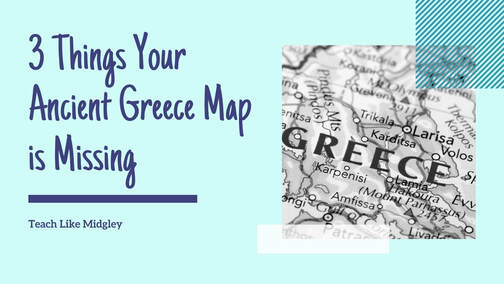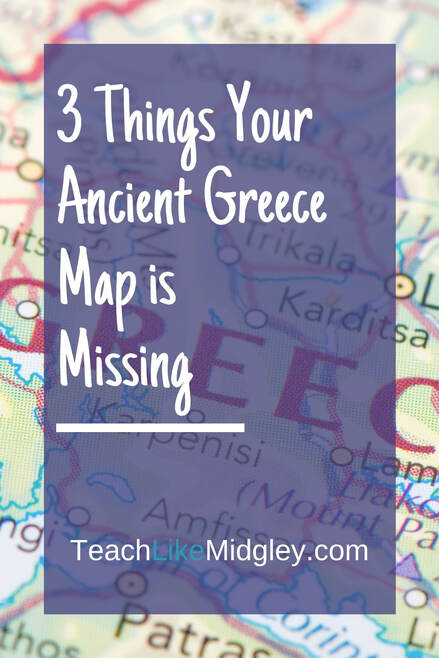3 Things Your Ancient Greece Map is Missing
Day one of your ancient Greece unit, and likely you have a map of Greece somewhere in your plans. When we teach about location, it is only natural that we would be using a map to do so.
But what type of map is best?
Well, that usually depends on your intent for how the map will be used.
When we teach ancient civilizations, one of our goals is to help students understand where these societies existed in the world, so long ago.
But what type of map is best?
Well, that usually depends on your intent for how the map will be used.
When we teach ancient civilizations, one of our goals is to help students understand where these societies existed in the world, so long ago.
But how can we help students understand what locations were like long ago and still give them frame of reference for what exists in these locations today?
Full comprehension of location involves the blending of 3 major components. This post will tell you about these 3 components, that are likely what you are missing from your ancient Greece map, and every other map you are using to teach ancient civilizations too.
#1 Why it was Chosen
One of the most fundamental aspects of any civilization is the location. In fact, having a location is part of the definition of being a permanent settlement. Although to be considered an actual civilization, there are other components that must be present.
When I teach a unit on any civilization, I always start with location. The geographical features of a location play a very large part in a civilization’s culture. Everything from the food they can grow to types of structures they can build.
Now, your map may include the labels of geographic features. But aside from referencing and learning their names, do you take the time to help students understand why these features created a good location for the people who lived there?
When I teach a unit on any civilization, I always start with location. The geographical features of a location play a very large part in a civilization’s culture. Everything from the food they can grow to types of structures they can build.
Now, your map may include the labels of geographic features. But aside from referencing and learning their names, do you take the time to help students understand why these features created a good location for the people who lived there?
#2 The Blend of Past and Present
Once students understand why a group of people chose to settle in a particular location long ago, we must also address the change in that society over time and what exists in this location today.
Some ancient cultures, like Greece, were conquered, yet their culture lives on. For ancient Greece, it is a big thanks to Alexander the Great for spreading the culture and ensuring its survival.
Most ancient cultures live on in some form or fashion and can be identified in the present-day country that exists in the location today. Ancient Egypt, China, and Rome are excellent examples.
Helping 6th graders distinguish the difference between continent and country can be a challenge. Many struggle with this, which means they need as much practice as you can give them.
Some ancient cultures, like Greece, were conquered, yet their culture lives on. For ancient Greece, it is a big thanks to Alexander the Great for spreading the culture and ensuring its survival.
Most ancient cultures live on in some form or fashion and can be identified in the present-day country that exists in the location today. Ancient Egypt, China, and Rome are excellent examples.
Helping 6th graders distinguish the difference between continent and country can be a challenge. Many struggle with this, which means they need as much practice as you can give them.
#3 Learning Strategies
Using a few maps and completing a few worksheets is not enough for your students to master the concepts of location for ancient societies. They need more than that.
I teach each ancient civilization as a 4 ½ week unit. The first objective we focus on is always location. After our first lesson on location, I distribute a blank and labeled map to students for study. I allow for approximately 2 weeks of study time for the test. During those two weeks, our lessons frequently include information about the civilization’s location and food supply, during which time I am often referencing their maps. Whenever there is extra time at the end of a lesson, I have students pull out their maps and partner study.
At the start of the year it is often helpful to share different study strategies with students.
+ Recite: recite the words in each category, either individually or in small groups.
+ Visualize: ask “what does this shape remind me of?” to make a connection. Thinking of that object can help to remember the name. It is also helpful to ask: “what do the letters in the name remind me of?” in order to connect the name to the shape. To reinforce this connection, when naming the places, touch the location on the map.
+ Categorize: recite the names by category, touching each place on the map as it is named.
I strongly advise you to practice with your class regularly. There is no replacement for student confidence when it comes to tests. Show them how to make their own practice tests by randomly assigning numbers on a blank map.
It is also beneficial to explain the directions with students before you hand out the tests.
These tests are highly focused on memorization skills. While some students may struggle at first, usually it just takes time to find the method that will work for that particular student. I have found that most students will find success with these tests when provided support. It can be a real confidence booster for students who can sometimes struggle in social studies class.
I teach each ancient civilization as a 4 ½ week unit. The first objective we focus on is always location. After our first lesson on location, I distribute a blank and labeled map to students for study. I allow for approximately 2 weeks of study time for the test. During those two weeks, our lessons frequently include information about the civilization’s location and food supply, during which time I am often referencing their maps. Whenever there is extra time at the end of a lesson, I have students pull out their maps and partner study.
At the start of the year it is often helpful to share different study strategies with students.
+ Recite: recite the words in each category, either individually or in small groups.
+ Visualize: ask “what does this shape remind me of?” to make a connection. Thinking of that object can help to remember the name. It is also helpful to ask: “what do the letters in the name remind me of?” in order to connect the name to the shape. To reinforce this connection, when naming the places, touch the location on the map.
+ Categorize: recite the names by category, touching each place on the map as it is named.
I strongly advise you to practice with your class regularly. There is no replacement for student confidence when it comes to tests. Show them how to make their own practice tests by randomly assigning numbers on a blank map.
It is also beneficial to explain the directions with students before you hand out the tests.
These tests are highly focused on memorization skills. While some students may struggle at first, usually it just takes time to find the method that will work for that particular student. I have found that most students will find success with these tests when provided support. It can be a real confidence booster for students who can sometimes struggle in social studies class.
Ready to Roll Materials
As you can see, you need more than just a map in a book to teach your students location about ancient civilizations.
Ideally you want your ancient Greece map to incorporate why early people settled here and the influence geographic features had on their culture, a blend from past to present, and opportunities for students to learn and comprehend.
Finding one map that will incorporate all of these things can be quite a challenge. Which is why I developed my own materials. And I’m happy to share that I have these materials available to you.
These resources come to you in the form of Map Test Sets and include the following:
+ Labeled Map – with geographic features and present-day countries.
+ Blank Map – for students to practice with.
+ A Map Test – where students label the geographic features and identify the present-day countries, continent, and specific question about the region.
+ Map Test Answer Key
In my Teachers Pay Teachers store, you will find each Map Test Set available individually, or in a money saving bundle.
Ideally you want your ancient Greece map to incorporate why early people settled here and the influence geographic features had on their culture, a blend from past to present, and opportunities for students to learn and comprehend.
Finding one map that will incorporate all of these things can be quite a challenge. Which is why I developed my own materials. And I’m happy to share that I have these materials available to you.
These resources come to you in the form of Map Test Sets and include the following:
+ Labeled Map – with geographic features and present-day countries.
+ Blank Map – for students to practice with.
+ A Map Test – where students label the geographic features and identify the present-day countries, continent, and specific question about the region.
+ Map Test Answer Key
In my Teachers Pay Teachers store, you will find each Map Test Set available individually, or in a money saving bundle.
You May Also Like...
Let's Connect...

Welcome! I'm Hillary Midgley, a veteran 6th grade teacher.
I create educational materials and develop curriculum for other teachers. I specialize in teaching students how to learn through my Study Skills Curriculum. I have established fundamental classroom systems and structures for teachers to help them streamline their classroom. And my passion is teaching ancient history through engaging activities with foundations in academic skills. Here you will find resources on all of these topics and more. Learn more about me here.
I create educational materials and develop curriculum for other teachers. I specialize in teaching students how to learn through my Study Skills Curriculum. I have established fundamental classroom systems and structures for teachers to help them streamline their classroom. And my passion is teaching ancient history through engaging activities with foundations in academic skills. Here you will find resources on all of these topics and more. Learn more about me here.
|







